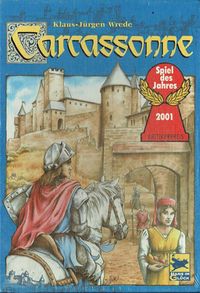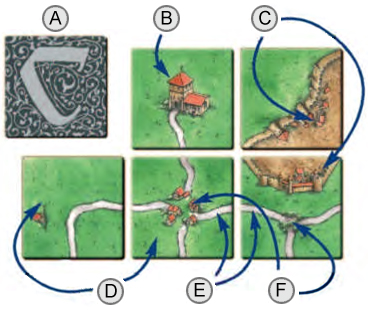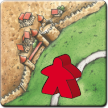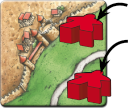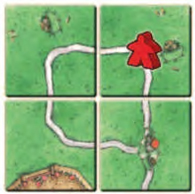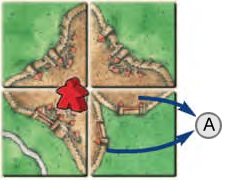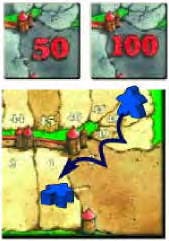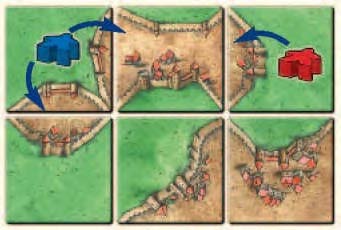Grundspiel (Erste Edition)
Allgemeine Informationen und Kommentare
Ursprünglich veröffentlicht von Hans im Glück in 2000
Ein cleveres Kartenlege-Spiel für 2 bis 6 Spieler ab 8 Jahren von Klaus-Jürgen Wrede.
Die südfranzösische Stadt Carcassonne ist bekannt für ihre einzigartigen römischen und mittelalterlichen Befestigungen. Die Spieler nehmen ihre Chancen mit ihren Gefolgsmännern in den Städten, Klöstern, Wiesen und auf den Straßen rund um Carcassonne wahr. Die Entwicklung des Landes liegt in ihren Händen, und der geschickte Einsatz der Gefolgsmänner als Wegelagerer, Ritter, Mönche und Bauern ist der Weg zum Erfolg.
Inhalt
- 72 Karten (einschließlich einer mit dunkler Rückseite), die Straßen-, Stadt- und Feldabschnitte sowie Klöster und Kreuzungen darstellen.[1]
Jeder Gefolgsmann kann als Ritter, Mönch, Dieb oder Bauer eingesetzt werden. Ein Gefolgsmann jeder Farbe wird als Bewertungsmarker verwendet.
- Eine Zählleiste. Diese wird verwendet, um die Ergebnisse der Spieler zu verfolgen.
- Ein Regelbuch und eine Ergänzung.
Regeln
Übersicht
Die Spieler platzieren die Karten Zug um Zug. Dies führt zum Wachstum von Straßen, Städten, Kreuzgängen und Bauernhöfen, auf denen die Spieler ihre Gefolgsmänner einsetzen können, um Punkte zu sammeln. Da sowohl während des Spiels als auch am Ende Punkte gewonnen werden können, steht der Gewinner erst in der Endwertung fest.
Vorbereitung
Die Startkarte befindet sich in der Mitte des Tischs.[4] Die restlichen Karten werden gemischt und in mehreren Stapeln verdeckt auf den Tisch gelegt, so dass jeder Spieler leicht darauf zugreifen kann. Die Karten können aber auch in einen Sack gesteckt und nach dem Zufallsprinzip gezogen werden.</ref> Die Zählleiste sollte möglichst am Tischrand platziert werden.
Jeder Spieler wählt eine Farbe aus und erhält die acht Gefolgsmänner, wovon er einen auf die Zählleiste auf das 0-Feld. Die restlichen sieben Gefolgsmänner bleiben für den Moment beim Spieler, als sein Vorrat.
Der jüngste Spieler entscheidet, wer das Spiel beginnt.[5]
Playing the game
Das Spiel läuft im Uhrzeigersinn ab. Der Spieler, der an der Reihe ist, führt folgende Schritte in der angegebenen Reihenfolge aus:
- Der Spieler muss eine neu gezogene Karte anlegen.
- Der Spieler kann einen Gefolgsmann aus seinem Vorrat nehmen und auf die gerade angelegte Karte setzen.
- Wenn Straßen, Städte oder Klöster durch die Platzierung der Karte abgeschlossen sind, müssen sie direkt gewertetwerden.
Dann ist der nächste Spieler an der Reihe.
1. Anlegen einer Karte
Als erste Aktion muss der Spieler eine Karte von einem der Stapel ziehen. Die Karte wird dann den anderen Spielern gezeigt (damit sie den Spieler darüber 'beraten' können, wo er sie platzieren soll) und auf den Tisch gelegt. Der Spieler folgende Punkte beachten:
- Mindestens eine Seite der neuen Karte (mit einem roten Rand in den Beispielen unten) muss eine oder mehrere Karten berühren, die bereits im Spiel sind.[6] Die Legen Ecken an Ecken ist nicht erlaubt.
- Alle Stadt-, Straßen- und Stadtteile müssen die bereits im Spiel befindlichen Karten fortsetzen. [7] [8]
In dem seltenen Fall, dass eine Karte nicht gelegt werden kann, und alle Spieler sind sich einig, wird diese aus dem Spiel entfernt, und der Spieler zieht eine neue.[9] [10]
2. Setzen eines Gefolgsmanns
Wenn der Spieler die Karte gelegt hat, kann er einen Gefolgsmann setzen. Dabei sind die folgenden Punkte zu beachten:
- Pro Runde darf nur ein Gefolgsmann gesetzt werden.
- Der Gefolgsmann muss aus dem Vorrat des Spielers kommen.
- Der Gefolgsmann darf nur auf die gerade gelegte Karte gesetzt werden.
- Der Spieler muss entscheiden, auf welchen Teil der Karte der Gefolgsmann [11] [12] als beide:
- Es darf kein anderer Gefolgsmann (nicht einmal ein Gefolgsmann desselben Spielers) auf der Straße, Stadtteil oder Wiese sein, die mit dem gerade gelegten Karte verbunden sind. Es spielt keine Rolle, wie weit der Gefolgsmann entfernt ist. Die folgenden beiden Beispiele sollten die Sache klären:
Wenn einem Spieler im Laufe des Spiels die Gefolgsmänner ausgehen, darf er nur noch Karten legen. Aber keine Panik: Sie können auch Gefolgsmänner zurückbekommen.
Jetzt ist der Zug des Spielers beendet, und es ist der nächste Spieler auf der linken Seite an der Reihe.
With the following exception: if a road, city or cloister was completed through the placement of the tile, it must now be scored.[13]
3. Score completed roads, cities or cloisters
A completed road
A road is completed when the road segments on both sides end in a crossing,[14] a city segment, or a cloister, or when the road forms a closed circle. [15]There is no limit to the number of road segments which can lie between these endings.
A player who has a thief on this completed road scores as many points as the road is long, decided by counting the number of tiles.[16]
Whenever points are scored, they are immediately recorded on the scoreboard (more on this in the section about the scoreboard).
A completed city
A city is completed when its segments are fully encompassed by a city wall and there are no gaps within the city.[17] There is no limit to how many segments a city may contain.
A player who has a knight in a completed city scores 2 points for every city segment. [18] Every pennant (banner / shield symbol)[19] scores an extra 2 points.
What happens if there are several followers on a completed road or in a completed city?
Through the wily placement of land tiles it is quite possible for several thieves to be on a road, or for several knights to occupy a city.
The points are then scored by the player with the most thieves or knights.[20] In the case of a draw, all players involved score the full number of points.
A completed cloister (monastery)
A cloister is completed when it is surrounded by eight land tiles. The player who has a monk in the cloister immediately scores 9 points—1 point for every land tile.
Returning followers to their owners
After a road, city, or cloister has been completed and scored – and only then – any thieves, knights, or monks involved are returned to their owner. From the next turn onwards, the player can then use them again in whatever role he or she chooses.
It is possible to deploy a follower, score immediately, and have the follower returned, all in the same turn. In this case, you must use the following order: [21]
- Complete a road, city or cloister with the new tile.
- Deploy a thief, knight or monk.
- Score the completed road, city or cloister.
- Return the thief, knight or monk to your supply.
Wiesen
Several connected field segments form a farm.[22] Farms and field segments are not scored. They serve only as places to deploy farmers; the owner of the farm only scores points at the end of the game. As such, farmers remain on the farm for the duration of the game and are never returned to their owner! [23] In order to make that clear, the farmers should be laid on their backs.
Farms are separated from each other by roads, cities and the edge of the playing field – this is important during the final scoring.[24]
Die Zählleiste
Any points scored should be recorded on the scoreboard immediately. The board is a track of fifty fields that can be lapped many times. When the field "0" is reached or passed the player takes a point tile (from Inns and Cathedrals) and places it in plain view of all other players, with the number "50" face up. In this way it is clear to all that the player has already scored 50 points or more [25] If the player reaches or passes the field "0" again, they should turn the point tile over so that the number "100" is face up. It is quite possible that the player might lap the circuit a third time: then he or she should take another point tile and display it next to the first, the "50" face up.[26]
The End of the Game
The game ends at the end of the turn in which the last land tile is placed.[27] Any roads, cities, and cloisters completed in this round are scored as usual. This is followed by the final scoring.
Endwertung
Wertung unvollständiger Strassen, Städte und Klöster
The first things to be scored during the final scoring are the incomplete roads, cities and cloisters. For every incomplete road, city and cloister the owner scores 1 point for every segment. Pennants also now score only 1 point.[28] As soon as the feature in question has been scored, the followers involved are removed.
Wiesen Wertung
Only the farmers and their farms are left, and these will be scored now. The owner of each farm should be established. If several players have farmers on a given farm, then the player with the most farmers is the owner. In the case of a draw, all the players with the most farmers are considered to be owners. The owner (or owners) of the farm score 3 points for every completed city which borders the farm, or lies within it.[29] [30] If a city borders more than one farm, the owner(s) of each farm score(s) 3 points for the city.[31] [32]
Every farm scores the bordering cities[33] in the same way. When this has been done, the game is over.
The player with the most points wins.[34]
Beispiel für Wiesen-Wertung
Here is a more detailed example of how farmers and their farms are scored.
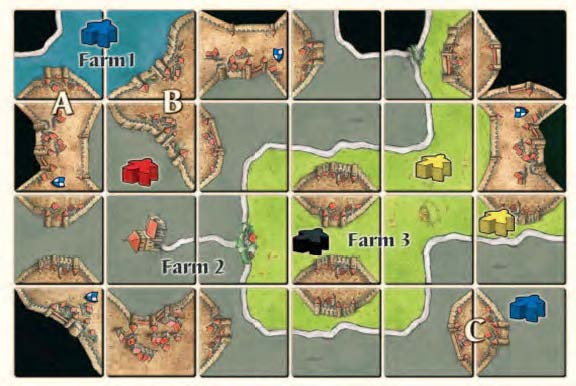
* Farm 1: BLUE owns farm 1. Two completed cities (A and B) border the farm. For each completed city BLUE scores 3 points (irrespective of their size), or a total of 6 points.
* Farm 2: RED and BLUE own farm 2. There are three completed cities (A, B and C) bordering or lying within this farm. RED and BLUE therefore score 9 points each.
Notice that cities A and B score points for BLUE on farm 1 as well as RED and BLUE on farm 2, since these cities border both farms. The city on the bottom left is incomplete, and so generates no points.
* Farm 3: YELLOW owns farm 3, since YELLOW has more farmers on it than BLACK. There are four completed cities bordering or lying within farm 2, so YELLOW scores 12 points.
Haus-Regeln
- The players decide who starts the game by any method they choose—such as by rolling three followers. The first player to ‘roll’ a standing follower decides who plays first. (Thanks to Joff.)
- To determine the first player; each player draws a tile from the bag, the player that drew the tile with the most roads (0 to 4) plays first, if there is a tie for most roads, a draw-off takes place. This is repeated until someone wins. (Thanks to michael.)
- Take your next tile at the end of your turn, to give you time to think about placement and avoid analysis paralysis.
- Play with a three-tile hand. The abbey counts as part of your hand. Play your turn. including the builder, and then draw back up to three tiles. These tiles could be visible to all or hidden to the other players (Thanks to DavidP and youth.)
- When playing with a bag for the tiles, the original starting tile may be put into the bag, and unplayable tiles can be put back into the bag rather than set to one side. (Thanks to dwhitworth.)
- Trees (bushes) on roads do not end the road—only houses do (when the road forks). This makes road building a lot more dynamic. (Thanks to Tobias.)
- When a tile is the only tile which can currently complete a structure, other players can offer to ‘buy’ it by offering points, trades counter, abbey, and so on. (Thanks to Deatheux.)
- If you place a tile that fills a hole in the playing field by touching something on all four adjacent sides, you get another turn. This helps motivate people to finish the board even if they do not get an advantage from the placement. (Does not apply to the abbey tile). (Thanks to viberunner.)
- Incomplete features at the end of the game do not score points at the end of the game. (Thanks to metoth.)
- The edge of the table limits the playing area. Thus, a player may not place a tile past the edge of the table or move the playing area to place a tile that would have been past the edge of the table. (Thanks to metoth for prompting this one, and to SkullOne for pointing out that this is an official rule from Hunters and Gatherers.)
- Table borders COMPLETE features as an abbey would. (Thanks to PreGy.)
- Use colored dice instead of meeples on the scoring track. Start out with the 6 showing on top. When the marker completes one lap, turn it to the number 1 to indicate it has completed one lap. This shows at a glance which player is on what lap and who's ahead. On the 100 space track it’s even easier to determine someone’s score at a glance. (Thanks to Carcking.)
Use of a Table
A number of questions have been asked about rules related to the play area itself, including what happens when the edge of the area is reached, or if a table has to be used for play. The following clarifications are from Georg Wild from HiG (5/2013):
- The edge of the table is the limit for the game if, as stated in the rules, a table is used.
- The rules state that the starting tile is placed in the middle of the table. If all of the tiles are shifted to allow more room, the starting tile would no longer be in the middle. So in principle, total shifting of the tiles is not allowed. Additionally, with a manual shift of all of the tiles, the tiles and figures on the field can slip, which could lead to incorrect positioning of tiles or figures.
- Addition of a second table is possible if one of an appropriate height is added to the first table. If a table is extended (as with an additional panel), make sure that the tiles and figures on the playing field do not slip.
- Playing on the floor: The rules technically do not allow this, because the rules state that the first tile is placed in the middle of the table. Playing on the floor is not forbidden, however, if use of a table is not feasible. If the floor is used, tiles must be placed so all tiles are visible to all players. Tiles cannot be placed under the sofa, cabinet/shelf, etc.
- It is important generally, that all the players in the round agree how to play:
- Table - Standard
- Table - with "total shifting" of tiles
- Table - with extension
- Floor
- Continue to play fairly and not intentionally unfair to other players.
Tile Distribution
Total Tiles: 72[35]
Underlined number includes starting tile.
Footnotes
For Icons explanation and licensing please visit Icons page.
- ↑
 Die RGG' Ausgabe der Big Box, die The River enthält, fügt hier den folgenden Satz hinzu:
"Die 12 Flusskarten sind NICHT Teil des Basisspiels, haben aber die gleiche Rückseite wie die Startkarte."
Die RGG' Ausgabe der Big Box, die The River enthält, fügt hier den folgenden Satz hinzu:
"Die 12 Flusskarten sind NICHT Teil des Basisspiels, haben aber die gleiche Rückseite wie die Startkarte."
- ↑
 Zu wenig Gefolgsmänner - spielen wir falsch oder gibt es wirklich zu wenig? Antwort: Aus unserer Sicht gibt es nicht zu wenige. Ein gewisser Mangel an Anhängern ist durchaus beabsichtigt. Ein wichtiges Element des Spiels ist es, genau zu lernen, mit seinen Anhängern sparsam umzugehen.
84px|frame|keine|Follower-Mangel
Zu wenig Gefolgsmänner - spielen wir falsch oder gibt es wirklich zu wenig? Antwort: Aus unserer Sicht gibt es nicht zu wenige. Ein gewisser Mangel an Anhängern ist durchaus beabsichtigt. Ein wichtiges Element des Spiels ist es, genau zu lernen, mit seinen Anhängern sparsam umzugehen.
84px|frame|keine|Follower-Mangel
- ↑
 Was die Big Box betrifft, so ist der sechste Satz (graue) Gefolgsmänner Teil des Grunspielsspiels, nicht Inns and Cathedrals. Zusätzlich fügt Große Box 5 lila und rosa Grfolgsmänner für bis zu 8 Spieler hinzu.
Was die Big Box betrifft, so ist der sechste Satz (graue) Gefolgsmänner Teil des Grunspielsspiels, nicht Inns and Cathedrals. Zusätzlich fügt Große Box 5 lila und rosa Grfolgsmänner für bis zu 8 Spieler hinzu.
- ↑
 Siehe Hinweise zu Verwendung des Tischs. (5/2013)
Siehe Hinweise zu Verwendung des Tischs. (5/2013)
- ↑
 Dieser Absatz stellt die aktuellen HiG Regeln dar. Die RGG Regeln besagen, dass die Spieler untereinander entscheiden, wer der Startspieler ist, und die ZMG Regeln erwähnen beide Optionen.
Dieser Absatz stellt die aktuellen HiG Regeln dar. Die RGG Regeln besagen, dass die Spieler untereinander entscheiden, wer der Startspieler ist, und die ZMG Regeln erwähnen beide Optionen.
- ↑
 Wir haben Schwierigkeiten zu entscheiden, wann eine gelegte Karte eine neue Stadt ist oder sie zu einer bereits im Bau befindlichen gehört. Antwort:Ecke an Ecke ist keine Verbindung! Stadtteile können nur an den Kanten verbunden werden. Im gezeigten Beispiel gibt es im Moment zwei Städte. frame|none|Ecke an Ecke
Wir haben Schwierigkeiten zu entscheiden, wann eine gelegte Karte eine neue Stadt ist oder sie zu einer bereits im Bau befindlichen gehört. Antwort:Ecke an Ecke ist keine Verbindung! Stadtteile können nur an den Kanten verbunden werden. Im gezeigten Beispiel gibt es im Moment zwei Städte. frame|none|Ecke an Ecke
- ↑
 Die Klöster können direkt nebeneinander oder Eck für Eck platziert werden. Es ist nicht notwendig, dass acht weitere (nicht getarnte) Karten an ein Kloster angrenzen. Ein Kloster steht in der Mitte eines Feldsegments und andere Segmente können daneben platziert werden. Im Gegensatz zu Straßen, Städten und Feldern ist es nicht möglich, sich mit einem Kreuzgang zu verbinden.
Die Klöster können direkt nebeneinander oder Eck für Eck platziert werden. Es ist nicht notwendig, dass acht weitere (nicht getarnte) Karten an ein Kloster angrenzen. Ein Kloster steht in der Mitte eines Feldsegments und andere Segmente können daneben platziert werden. Im Gegensatz zu Straßen, Städten und Feldern ist es nicht möglich, sich mit einem Kreuzgang zu verbinden.
- ↑
 Ein neu verlegter Bodenbelag muss an allen Kanten in das angrenzende Gelände passen. Bei der Platzierung reicht es nicht aus, nur nach einer Seite zu suchen, die passt. Frame|none|Illegale Fliesenplatzierung
Ein neu verlegter Bodenbelag muss an allen Kanten in das angrenzende Gelände passen. Bei der Platzierung reicht es nicht aus, nur nach einer Seite zu suchen, die passt. Frame|none|Illegale Fliesenplatzierung
- ↑
 Alternativ, wenn mit Abteien gespielt, kann der Spieler die Abteikarte legen, anstatt eine weitere Karte zu ziehen. (1/2013)
Alternativ, wenn mit Abteien gespielt, kann der Spieler die Abteikarte legen, anstatt eine weitere Karte zu ziehen. (1/2013)
- ↑
 Wenn Sie die Karten aus einem Beutel ziehen, kann die Karte, die nicht gelegt werden kann, zurück in den Beutel gegeben werden.
Wenn Sie die Karten aus einem Beutel ziehen, kann die Karte, die nicht gelegt werden kann, zurück in den Beutel gegeben werden.
- ↑
 gesetzt wird. Wenn Sie beim Legen einer Karte eine zuvor unbesetzte Stadt abschließen, müssen Sie diese Stadt nicht besetzen und die Punkte verdienen. Sie können die Stadt schließen, ohne dass sie besetzt ist, und (zum Beispiel) einen Bauer setzen, solange die Wiese unbesetzt ist. Die Stadt benötigt nicht unbedingt einen Ritter, der sich um sie kümmert.
gesetzt wird. Wenn Sie beim Legen einer Karte eine zuvor unbesetzte Stadt abschließen, müssen Sie diese Stadt nicht besetzen und die Punkte verdienen. Sie können die Stadt schließen, ohne dass sie besetzt ist, und (zum Beispiel) einen Bauer setzen, solange die Wiese unbesetzt ist. Die Stadt benötigt nicht unbedingt einen Ritter, der sich um sie kümmert.
- ↑
 Darf man bei Kloster-Karten einen Gefolgsmann auf die Umgebung (auf der Karte) setzen? Antwort: Ja! Für die Umgebung der Klöster gelten die gleichen Regeln wie für jedes andere Karte. Du kannst auch einen Bauern neben einem Kloster einsetzen. In diesem Fall bleibt das Kloster für den Rest des Spiels unbesetzt [Es sei denn, das Kloster wird über ein Zaubergang oder von einem Gefolgsmann in Carcassonne-ed besetzt.]
frame|none|Setzen eines Gefolgsmannsauf einem Feld neben dem Kloster
Darf man bei Kloster-Karten einen Gefolgsmann auf die Umgebung (auf der Karte) setzen? Antwort: Ja! Für die Umgebung der Klöster gelten die gleichen Regeln wie für jedes andere Karte. Du kannst auch einen Bauern neben einem Kloster einsetzen. In diesem Fall bleibt das Kloster für den Rest des Spiels unbesetzt [Es sei denn, das Kloster wird über ein Zaubergang oder von einem Gefolgsmann in Carcassonne-ed besetzt.]
frame|none|Setzen eines Gefolgsmannsauf einem Feld neben dem Kloster
- ↑
 Question: There is a situation that puzzles us. If a player draws a tile with two city segments and completes a small city, earning 4 points, can he or she then deploy a follower to a new city segment in the same turn?
Answer: A player may only deploy one follower per turn, and that follower may be deployed only once, and it must be before any scoring. If the player already occupies the small, now-completed city, he or she may deploy a second follower to the other city segment immediately after placing the tile. The small city will then be scored and the follower involved returned to the player. If the player does not yet occupy this city, he or she can decide which of the two city segments to deploy a follower to. If the follower is deployed to the small city, it will be returned immediately and the player will earn four points, but the follower cannot be redeployed.
Question: There is a situation that puzzles us. If a player draws a tile with two city segments and completes a small city, earning 4 points, can he or she then deploy a follower to a new city segment in the same turn?
Answer: A player may only deploy one follower per turn, and that follower may be deployed only once, and it must be before any scoring. If the player already occupies the small, now-completed city, he or she may deploy a second follower to the other city segment immediately after placing the tile. The small city will then be scored and the follower involved returned to the player. If the player does not yet occupy this city, he or she can decide which of the two city segments to deploy a follower to. If the follower is deployed to the small city, it will be returned immediately and the player will earn four points, but the follower cannot be redeployed.
- ↑
 In the game there are crossings and junctions. But since all crossings have the same effect—namely, to bring a road to an end—it was decided to sacrifice the distinction between crossings and junctions (or T-crossings, or T-roads...?) in order to not unnecessarily complicate matters.
In the game there are crossings and junctions. But since all crossings have the same effect—namely, to bring a road to an end—it was decided to sacrifice the distinction between crossings and junctions (or T-crossings, or T-roads...?) in order to not unnecessarily complicate matters.
- ↑
 Question: Can a road end in nothing? Answer: No, like all the usual land tiles, a road segment must continue to another road segment on all edges.
Question: Can a road end in nothing? Answer: No, like all the usual land tiles, a road segment must continue to another road segment on all edges.
- ↑
 Question: How are the road segments between T-junctions scored? Are the horizontal segments (on top of the T) also ends, or do these count as straight roads that have to be completed elsewhere? Answer: Every crossing (or junction) ends a road, irrespective of which direction they reach the junction from. The thieves cannot enter the small villages on the junctions either. In the example shown, every thief is on its own road.
Question: How are the road segments between T-junctions scored? Are the horizontal segments (on top of the T) also ends, or do these count as straight roads that have to be completed elsewhere? Answer: Every crossing (or junction) ends a road, irrespective of which direction they reach the junction from. The thieves cannot enter the small villages on the junctions either. In the example shown, every thief is on its own road.
- ↑
 The RGG edition states rather confusingly that “a city is complete when the city is completely surrounded by a city wall and there are no gaps in the wall.” Obviously, a city cannot be completely surrounded by a wall, and the wall have gaps at the same time. It is the city itself which cannot have gaps, as the HiG rules make clear.
The RGG edition states rather confusingly that “a city is complete when the city is completely surrounded by a city wall and there are no gaps in the wall.” Obviously, a city cannot be completely surrounded by a wall, and the wall have gaps at the same time. It is the city itself which cannot have gaps, as the HiG rules make clear.
- ↑
 Note that the so-called ‘small city’ rule is no longer used in any edition. This rule stated that a city of two segments—the smallest possible completed city— scored only 2 points, or 1 point per tile. Pennants in a small city also scored only 1 point each. However, small cities are now scored in the same way as every other city: that is, 2 points for every city segment, and 2 points per pennant.
Note that the so-called ‘small city’ rule is no longer used in any edition. This rule stated that a city of two segments—the smallest possible completed city— scored only 2 points, or 1 point per tile. Pennants in a small city also scored only 1 point each. However, small cities are now scored in the same way as every other city: that is, 2 points for every city segment, and 2 points per pennant.
- ↑
 Note that a pennant only affects the city segment it is in, not the whole tile (if there is more than one segment on a single tile).
Note that a pennant only affects the city segment it is in, not the whole tile (if there is more than one segment on a single tile).
- ↑
 When two followers of one color are occupying a road, city, or farm, you DO NOT score double in these cases. The number of followers (or in Inns and Cathedrals the size of the followers) has no effect on the points that a player earns from a road, city, cloister, or farm. Two knights do not double the points. The number of followers is only important in establishing who has the majority.
When two followers of one color are occupying a road, city, or farm, you DO NOT score double in these cases. The number of followers (or in Inns and Cathedrals the size of the followers) has no effect on the points that a player earns from a road, city, cloister, or farm. Two knights do not double the points. The number of followers is only important in establishing who has the majority.
- ↑
 Note in the box that features are considered to be complete as soon as the tile is placed, although follower placement and scoring only occur afterwards. This is important when playing with The Flier.
Note in the box that features are considered to be complete as soon as the tile is placed, although follower placement and scoring only occur afterwards. This is important when playing with The Flier.
- ↑
 In determining farm size, farms can be limited by all kinds of barriers, for example, roads, cities, or rivers which cannot be circumvented, or the edge of the
playing field. It can certainly happen that a farm covers almost the entire playing field, and there will likely be farms that remain open for the entire game.
In determining farm size, farms can be limited by all kinds of barriers, for example, roads, cities, or rivers which cannot be circumvented, or the edge of the
playing field. It can certainly happen that a farm covers almost the entire playing field, and there will likely be farms that remain open for the entire game.
- ↑
 Okay, “never” is a long time. In reality, some special mechanics in some expansions (Festival tiles, the Dragon, etc.) do allow return of farmers to their owners. (12/2014)
Okay, “never” is a long time. In reality, some special mechanics in some expansions (Festival tiles, the Dragon, etc.) do allow return of farmers to their owners. (12/2014)
- ↑
 River segments also separate farms. (08/2014)
River segments also separate farms. (08/2014)
- ↑
 The graphic here suggests that it might also be a good idea to lie the follower being used as a scoring marker flat on the scoreboard as the "50" is passed.
The graphic here suggests that it might also be a good idea to lie the follower being used as a scoring marker flat on the scoreboard as the "50" is passed.
- ↑
 This is the first real difference to previously published editions, now having its own section and a description of point tiles, which were previously considered to be a part of the Inns and Cathedrals expansion.
This is the first real difference to previously published editions, now having its own section and a description of point tiles, which were previously considered to be a part of the Inns and Cathedrals expansion.
- ↑
 Note that, according to the RGG 3Big Box 3 rules, the last land tile placed could be an Abbey tile. According to these most recent rules, “If one or more players have not yet placed their Abbey tiles when the last landscape tile is drawn and placed, they may now do so, if possible, in clockwise order starting from the left of the person who placed the last tile. Then, the game ends.” This is a reversal of a previous FAQ, which used the statement, “The game is over when the last face-down land tile has been played.” This older statement was to specifically prevent players from placing any abbey tiles which they may still have in their hand after the last ‘normal’ land tile (from the stack, the bag, or the dispenser) had been played.
Note that, according to the RGG 3Big Box 3 rules, the last land tile placed could be an Abbey tile. According to these most recent rules, “If one or more players have not yet placed their Abbey tiles when the last landscape tile is drawn and placed, they may now do so, if possible, in clockwise order starting from the left of the person who placed the last tile. Then, the game ends.” This is a reversal of a previous FAQ, which used the statement, “The game is over when the last face-down land tile has been played.” This older statement was to specifically prevent players from placing any abbey tiles which they may still have in their hand after the last ‘normal’ land tile (from the stack, the bag, or the dispenser) had been played.
- ↑
 Question: Final scoring: segments of incomplete roads. 1 point per follower
or 1 point per road segment? Cloister: 1 point for every neighbouring tile (e.g. 5), or is an incomplete cloister worth only 1 point? Answer: During the final scoring, roads earn exactly as much as during the game, that is, 1 point per tile that the road occupies. In the example shown, BLUE earns four points at the end of the game. The only exception in the final scoring is a road with an inn from Inns and Cathedrals, which earns no points whatsoever at the end of the game. The cloister earns 1 point for the cloister itself and 1 point for every neighbouring tile. When there are five tiles surrounding the cloister it earns 6 in total.
Question: Final scoring: segments of incomplete roads. 1 point per follower
or 1 point per road segment? Cloister: 1 point for every neighbouring tile (e.g. 5), or is an incomplete cloister worth only 1 point? Answer: During the final scoring, roads earn exactly as much as during the game, that is, 1 point per tile that the road occupies. In the example shown, BLUE earns four points at the end of the game. The only exception in the final scoring is a road with an inn from Inns and Cathedrals, which earns no points whatsoever at the end of the game. The cloister earns 1 point for the cloister itself and 1 point for every neighbouring tile. When there are five tiles surrounding the cloister it earns 6 in total.
- ↑
 Question: It is unclear whether incomplete farms earn points during the final scoring. Answer: It is almost impossible to close off or complete most of the farms. The most important thing when scoring the farms are the cities, which do indeed have to be complete. So: completed cities count on incomplete farms as well.
Question: It is unclear whether incomplete farms earn points during the final scoring. Answer: It is almost impossible to close off or complete most of the farms. The most important thing when scoring the farms are the cities, which do indeed have to be complete. So: completed cities count on incomplete farms as well.
- ↑
 Question: At the end of the game, do we score farms which are completely closed off by roads, but which don't have any adjacent cities? If so, how? Answer: Strictly speaking, they should be scored exactly like every other farm, with 3 points for every completed city. In this case, that makes a total of zero points. And the farmer is nevertheless unable to leave the farm. All this is of course highly frustrating and cries out for revenge!
Question: At the end of the game, do we score farms which are completely closed off by roads, but which don't have any adjacent cities? If so, how? Answer: Strictly speaking, they should be scored exactly like every other farm, with 3 points for every completed city. In this case, that makes a total of zero points. And the farmer is nevertheless unable to leave the farm. All this is of course highly frustrating and cries out for revenge!
- ↑
 This describes what is known as the "third edition" method of scoring farms, the method currently accepted by all publishers.
This describes what is known as the "third edition" method of scoring farms, the method currently accepted by all publishers.
- ↑
 Question: What are the differences to the rules of the first edition, when
Carcassonne won Game of the Year? Answer: The scoring of farms was not from the perspective of the farms themselves, as it is now, but rather from the perspective of the cities. For every city, you had to check how many farmers of each color were adjacent to it, irrespective of from which side. The player with the majority of adjacent farmers supplying a city would earn four points for it. Each city would as such only be scored once, and therefore earned more points. According to the old rules, BLUE would be the only one to score points, since two of his or her farmers are supplying the cities, even though they are on different farms. YELLOW has only one farmer adjacent to
the city and goes home without anything. According to the new rules, both farmers earn points; and following the most recent rule changes, BLUE even earns points twice.
Question: What are the differences to the rules of the first edition, when
Carcassonne won Game of the Year? Answer: The scoring of farms was not from the perspective of the farms themselves, as it is now, but rather from the perspective of the cities. For every city, you had to check how many farmers of each color were adjacent to it, irrespective of from which side. The player with the majority of adjacent farmers supplying a city would earn four points for it. Each city would as such only be scored once, and therefore earned more points. According to the old rules, BLUE would be the only one to score points, since two of his or her farmers are supplying the cities, even though they are on different farms. YELLOW has only one farmer adjacent to
the city and goes home without anything. According to the new rules, both farmers earn points; and following the most recent rule changes, BLUE even earns points twice.
- ↑
 A bordering city is one that has a wall bordering the farm; a single point of contact at the corner of a tile is not sufficient.
A bordering city is one that has a wall bordering the farm; a single point of contact at the corner of a tile is not sufficient.
- ↑
 The HiG rules do not have any instructions regarding what to do in case of a tie. The RGG rules state that tied players “rejoice in their shared victory.” The ZMG rules state, “In case of a tie, play another game to determine the winner!”
The HiG rules do not have any instructions regarding what to do in case of a tie. The RGG rules state that tied players “rejoice in their shared victory.” The ZMG rules state, “In case of a tie, play another game to determine the winner!”
- ↑
 Big Box 5 actually includes these 72 tiles with standard backs as well as a separate starter tile. Thus, there is effectively an extra tile with a city cap and a horizontal road (CRFR, see Consolidated Tile Reference) in the Big Box 5 base set.
Big Box 5 actually includes these 72 tiles with standard backs as well as a separate starter tile. Thus, there is effectively an extra tile with a city cap and a horizontal road (CRFR, see Consolidated Tile Reference) in the Big Box 5 base set.
